Nature's Way
 |
| Ladybugs bringing good luck to everyone! |
Because I’ve spent all my other summers in the Pacific
Northwest, I haven’t yet gotten to see my Arivaca garden's sunflower patch in bloom. Nevertheless, I always
enjoy how the sturdy green shoots pop up out of the soil each spring and head up
towards the sun. So on the
day I started getting my drip irrigation up and running for the first time this
year, I saw that the bright green sunflower leaves had popped up, and I headed
over to check them out. Our
sunflower patch is planted in the bottom of the "Sombrero Pond", which we built
to catch and temporarily hold the monsoon storm water that runs off our patio
and lawn each summer. As soon as I got there though,
I could see clusters of black on almost every rosette of leaves, each a mass of
hungry aphids munching away.
 |
| Ladybug adult finding "Thanksgiving Dinner" |
Knowing that aphids are born pregnant (yes it’s true), which makes their reproduction rate astoundingly fast, I sprayed a shower of water at every aphid cluster except the one that the ladybug was feeding on. When I rechecked the next day, I found still just the one ladybug, and once again avoided it as I sprayed water to knock hundreds of black squirming aphids off the other plants. Ah… but on the third day, I was ecstatic to see that many more ladybugs had come to the rescue and were busy eating aphids!!! Tachnid flies and other beneficial insects were also doing their part to help, and there was absolutely no need for me to intervene in the delightful scene.
 |
| Tachnid Fly |
 |
| Unknown (to me) beneficial insect |
 |
| Ladybug larvae appear |
And so each day afterward, I saw more and more adult
ladybugs and larvae, and less and less aphids. Pupal cases appeared quickly too, making me realize that ladybugs
had been laying eggs in the vicinity at least a week or more before I first saw
them, and that I had undoubtedly also overlooked larvae already present by then.
Soon there were no aphids on any sunflowers in the patch. Knowing that plants already under some kind of stress can trigger aphids to attack them, one of the other things I had done after first seeing the aphids was to give gentle root zone irrigation to all the sunflowers, in case the big increase in daytime temperatures was stressing them.
When I thought to also check out a nearby New Mexico Aster that had been transplanted weeks before but was still suffering from root shock, I found ladybugs, larvae, and pupal cases on it too! The “ladybug squadron” just doesn’t leave town until it has cleaned up every neighborhood…
 | ||
| Now we got a party going on! |
Soon there were no aphids on any sunflowers in the patch. Knowing that plants already under some kind of stress can trigger aphids to attack them, one of the other things I had done after first seeing the aphids was to give gentle root zone irrigation to all the sunflowers, in case the big increase in daytime temperatures was stressing them.
 |
| Ladybug pupal case on New Mexico Aster plant |
When I thought to also check out a nearby New Mexico Aster that had been transplanted weeks before but was still suffering from root shock, I found ladybugs, larvae, and pupal cases on it too! The “ladybug squadron” just doesn’t leave town until it has cleaned up every neighborhood…
 |
| Sunflower plants now continuing skyward |
To see some fabulous closeup photos of the 4 stages of a Ladybug's life, including their beautiful golden eggs, click on this link. And to find out more about the wonderful world of beneficial insects, check out this free downloadable ID guide with life cycle photos and information about 18 common beneficials!
The sunflowers in my patch are now well over 2 ft tall, and their leaves and stems have outgrown any damage done to them by the aphids. Though there is no longer any sign of the “mass carnage” that went on there, I hope that each time I gaze upon the beautiful, golden sunflowers this summer, I remember to appreciate the web of life that can play out so well without my help. Those squirming aphids were not a “problem” at all… what really happened was that I just didn’t look long enough the first time I saw them on my sunflowers.
If I would have spent a few more minutes before deciding to intervene with my water spray, perhaps I would have seen that my help wasn’t needed at all, because a delicious feast was already well underway. Humbling and enlightening at the same time, a perfect example of nature’s way.
Photo credits:
All photos by Emily Bishton


